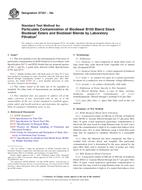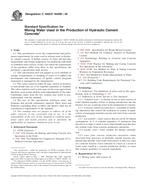1.1 This guide shall apply to FEMF as defined in Terminology E 1126. The guide is primarily intended for, but not exclusively limited to the evaluation of fermentation ethanol (ethyl alcohol) processes. This guide is primarily intended for, but not exclusively limited to, fermentation ethanol processes for small scale (less than 1 000 gal/day capacity) plants.
1.2 This guide applies to both batch process and continuous process FEMF systems. Since a wide variety of equipment configurations can exist, this guide will describe the necessary general requirements common to all FEMF facilities.
1.3 This guide is to be used in conjunction with applicable local, state, and Federal codes for designing, constructing, and operating FEMF facilities.
1.4 This guide is limited to use with plants possessing the following operational characteristics, which are fairly typical of small scale ethanol plants and are as follows:
1.4.1 Capacity: Up to 500 000-proof gal/year of 190-proof ethanol,
1.4.2 Normal Feedstocks: No. 2 yellow corn, or other suitable sample grade corn, barley, or grain sorghum (also referred to as milo). There are other starch grains such as wheat, rye, or oats, and starch tubers such as potatoes that can be used as feedstocks. Sugar crops (sugar cane, sugar beets, and molasses, that is a by-product of sugar plants) and cellulose crops (wood chips, straw, etc.) are also potential feedstock sources. However, since much of the interest in proposed ethanol plants in recent years has centered on the use of corn, barley, and milo as feedstocks for ethanol production, it is expected that the majority of plants proposed in the near future will be largely based on these abundant feedstocks. This guide concentrates on the use of corn, milo, and barley as feedstocks,
1.4.3 Normal Process Fuels: Natural gas, propane, fuel oil, wood, or coal,
1.4.4 Products: Ethanol at 190-proof or less. Distillers grains at 60 to 75 % moisture by weight and thin stillage, for use as animal grade feed and not human grade food,
1.4.5 Process: The ethanol production process referred to in this guide involves dry milling of grain, batch or continuous cooking, enzyme hydrolysis, batch fermentation, continuous distillation, and pressing or centrifuging for dewatering of stillage (for example, separating suspended solids from the stillage), and
1.4.6 Variations: One variation in the ethanol production process is addressed in this guide. This variation allows for the cooking, hydrolysis, and fermentation processes to be completed either as a batch in the same process vessel or in separate vessels.
With limitations, this guide can be used to evaluate facilities with operating characteristics that differ from those just listed. However, variations from those characteristics listed will tend to lessen the reliability of the guide.
An example of a fairly minor variation would be the substitution of wheat as a feedstock. Wheat processing characteristics are reasonably similar to those of corn, barley or milo. However, wheat tends to foam considerably more than corn, so vessels need to be sized at least 10 % greater than if corn is used, or the use of an antifoam agent would be advisable.
An example of a significant variation from the process characteristics utilized in this guide would be the substitution of potatoes as a starch feedstock. Processing requirements for use of potatoes vary significantly from processing requirements of corn, barley, and milo. Therefore, use of this guide is not recommended for evaluation of a potato feedstock ethanol facility.
1.5 Use of Guide as ChecklistThis guide should be used as a checklist for evaluation of proposed small scale manufactured fuel ethanol facilities. It is intended to be used by investors, bankers, and other parties interested in the commercial development of such fuel alcohol facilities. It is not intended to be used as a guide for the designing of these facilities, but as a guide to assist in the evaluation of designs already completed by sellers or manufacturers of such facilities. This guide may also be utilized by FEMF designers or sellers who may wish to review their systems’ conformance with the recommendations of the guide. This guide is to be used in conjunction with applicable local, state, and Federal codes and regulations.
1.6 The values stated in inch-pound units are to be regarded as the standard. The values given in parentheses are for information only.
This standard does not purport to address all of the safety concerns, if any, associated with its use. It is the responsibility of the user of this standard to establish appropriate safety and health practices and determine the applicability of regulatory limitations prior to use. For specific hazard statements, see Section on Hazards, and the safety sections for each procedure in Section .
1.7 This guide is arranged as follows:
Product Details
- Published:
- 02/01/2006
- Number of Pages:
- 25
- File Size:
- 1 file , 240 KB


